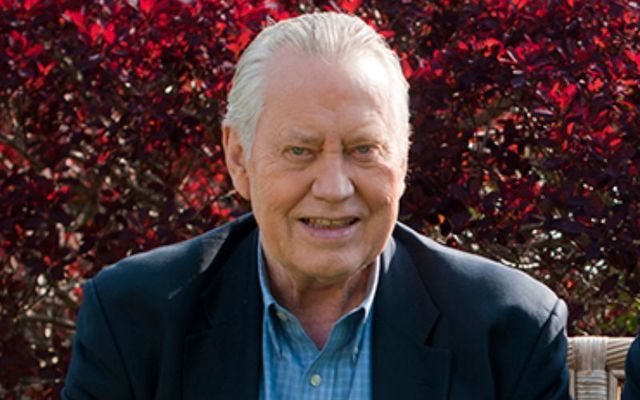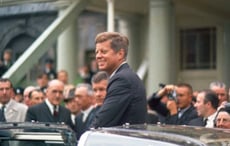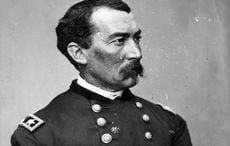It was the worst of times. On October 19, 1987, the US stock market plunged 22 percent and the crisis was quickly dubbed Black Monday. It was the largest one-day drop of the Dow Jones Index in history.
In the midst of the financial storm, I was in New York City, on my way to meet one Charles Feeney. A mutual friend had suggested the meeting.
All I knew was that he was a successful businessman who took pride in his Irish heritage and had set up an Irish American charity called the Irish-American Partnership.
It was not unusual for such requests from Irish Americans to meet as my magazine Irish America was a leading publication and my newspaper, the Irish Voice, would debut later in the year.
Kaplan’s coffee shop was on 59th and Broadway, a dingy, greasy spoon at odds with all the skyscrapers surrounding it. Kaplan’s doubled as Chuck’s office location in New York. He could have had any corner office suite, indeed a building full of them, but Kaplan’s was just fine to him.
He was waiting for me, a smallish man in a cheap coat and Irish tweed cap with a plastic bag filled with newspapers. You noticed his piercing blue eyes immediately. He was arguing with the older waitress over what he wanted on his bagel.
I almost made my excuses and departed but I realized the friendly argument about his bagel concealed a mutual affection. He left a $20 tip for her.
We settled down to talk. I learned quickly he had an incredible gift for sizing someone up instantly. Time after time in the 36 years I knew him, he was rarely wrong in his insights.
When it really mattered with huge issues on the line, such as whether to believe that the leaders of Sinn Féin, Gerry Adams and Martin McGuinness, were sincere in seeking peace, Chuck was unerringly right in his summation – and was ready to back his conviction with a million dollars to make sure the IRA cessation happened while also funding social and educational programs for the shunned loyalists too. I learned quickly Chuck Feeney was all in on whatever project he took on.
I arranged the first meeting between Adams and Chuck in a Dublin council house. The one-hour scheduled meeting turned into two and beyond. There was an immediate understanding between them.
In these times with peace in the North, we have forgotten just how much contempt men like Adams and McGuinness faced, and it was only the bravest of the brave, men like John Hume and Chuck, who reached into them.
Chuck and I would work diligently on Northern Ireland together, but on this gray New York Monday morning in Kaplan’s, he was on a different assignment. There were many stories of undocumented Irish flooding into the US because of dire hardship back home. He was interested in helping in any way.
I told him there was an upcoming meeting of the Irish Immigration Reform Movement which sought to address the lack of visas for the Irish. He agreed to attend.
One week later, Chuck showed up at a meeting in Woodside, Queens, and listened with rapt attention to the many tearful stories of young people unable to return to Ireland where there was no work but who were not part of America because of their undocumented status.
There were tales of true hardship, listening down the phone to funeral masses of beloved parents, being ripped off at work because employers knew their immigration status.
There and then, Chuck agreed to fund the campaign to change the immigration law. The Morrison visa movement was started and Chuck underwrote its activities, a fact barely known.
The Morrison campaign, called after the legendary Connecticut congressman who created it, allowed close to 50,000 new Irish-only green cards over a three-year period in the early 90s. The visas made a massive difference.
As was typical of Chuck, his name appeared nowhere in the credits, yet there are tens of thousands of Irish walking around America today who owe their legal status and lives in America to him and Morrison.
After that campaign, Chuck would often call when passing through New York and we became firm friends. I had no idea, other than the fact that he was in the duty-free business, what a financial colossus he was.
In the pre-Google age, that was not unusual. His veil of anonymity was truly shattered, though, when Forbes magazine in 1988 cited him as the 23rd richest man in America with a fortune of $1.3 billion mostly from his ownership of Duty Free Shops (DFS), the largest duty-free company in the world.
Feeney would eventually be assessed as worth $8 billion, but given the fact that he gave all the money away, Forbes badly missed the target.
Chuck was typically evasive. “Don't believe everything you read,” he said, claiming Forbes mixed him up with another guy, referring to a well-known top baseball executive named Chub Feeney.
Uneasy with his new fame, Chuck fled from the notoriety. He dealt with his wealth by planting his two feet underneath him, remaining true to his gritty New Jersey roots, and refusing to take his wealth as the only barometer of success in life.
He was certainly frugal as well as incredibly generous, and both things were not mutually exclusive.
I spent many weekends in his Connecticut home which he later sold. There was always an interesting clutch of visitors from the different parts of Chuck’s life. The business, philanthropic, Irish background types, educators, family, and friends, all mixed in eclectic fashion.
One weekend, early on a Saturday morning, he insisted we take a walk to a nearby town. What a walk it was, wending our way along back roads until we came to a library. Chuck went straight for the used magazine section taking a handful of old Time and Newsweeks and bringing them home with him.
On another celebrated occasion, I convinced him to go to the racetrack where a friend had a horse running. The horse should have been fitted with brake lights as he finished so far behind the others in the gathering darkness.
When asked to explain the miserable outing, he said, “Ah he’s a grand horse when he has a straight run but he doesn’t like to go around corners.” I can still see Chuck doubled over from laughing.
Chuck loved giving money away and was happiest when he could observe his own good deeds reach fruition. I saw him with a group of African kids who had their cleft lips and other facial anomalies corrected by Operation Smile doctors, one of the charities he strongly backed.
Likewise, at his beloved University of Limerick which he played a huge role in creating, I saw tears on his face as he watched young graduates march up on stage for their degrees.
Chuck was especially proud of his role in the North. It was inspired by the incredible generosity of spirit shown by Gordon Wilson, who forgave the IRA killers of his daughter Marie when a bomb exploded at a Remembrance Day event in Enniskillen in November 1987. Chuck felt it all the deeper as Fermanagh was where his Irish roots were.
So when I asked him over dinner at PJ Clarke’s in Manhattan to become involved in an Irish American initiative to help the peace process, he immediately agreed. He was undoubtedly the only businessman in America at the time who would have stepped so fearlessly into the cauldron of the Irish Troubles.
There were some crazy moments we shared. Once looking for a Sinn Féin meeting where we were due to discuss important developments, we got dropped off in the wrong area. There was no Uber back then and no way to get out of what was definitely a staunch Loyalist neighborhood.
We decided to knock on the closest door and ask for directions. When we knocked a rather large tattooed man answered the door and sized up the two besuited strangers. “Who the f*** are you?” he barked. “Are yez debt collectors? Get away from my house before I beat yez up.” Chuck and I got away as quick as we could.
Chuck’s frugality was also on full display when the five Irish Americans who were part of the peace process had to rent a car urgently to make an important meeting in Derry. He came back driving a car that looked like an old Morris Minor and took great delight in watching us all squeeze in.
His biggest intervention was when the peace process was on the line as Sinn Féin had sought $1 million to open an official office in Washington. I turned to Chuck and asked him to supply the funding. He nodded immediately. He was probably the only man on earth who would have agreed to take such a step.
When the Belfast Agreement was finally signed off on and all the parties met on May 8, 2007 to form the new Assembly, Chuck and I traveled to Stormont together to witness history in the making. That day belonged to Chuck as much as anyone given the extraordinary level of funding his company put behind the agreement. He was a very happy man that day.
History was made but few knew the role the quiet American from New Jersey had played in bringing peace to his ancestral land. As usual, he looked for no plaudits, only expressing the wish that the dream unfolding before our eyes would remain intact into the future. Chuck always believed it would.
I saw him for the last time when Helga, his devoted wife, and I wheeled him along to Fifth Avenue one St. Patrick's Day soon after he had major surgery and before he moved to San Francisco for the climate.
The theme of that year’s parade was peace in Ireland. Few among the throngs realized that a principal figure in securing the peace was on Fifth Avenue too, remembering those who had come before and the pride they had in their heritage.
Paradegoers that day were in the company of Chuck Feeney, arguably the greatest Irish American of all.




Comments